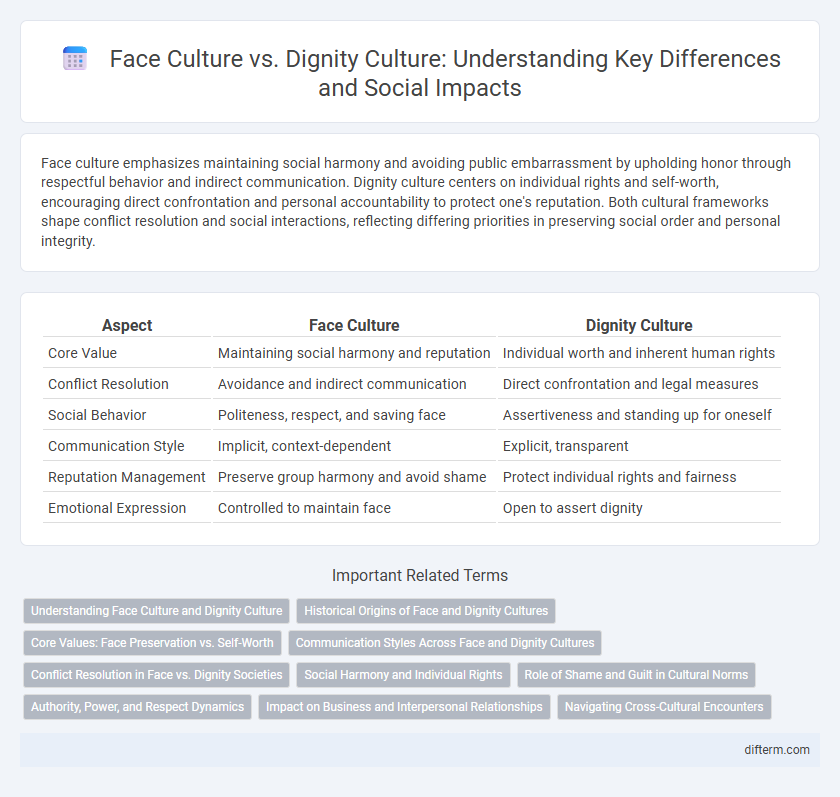Face culture emphasizes maintaining social harmony and avoiding public embarrassment by upholding honor through respectful behavior and indirect communication. Dignity culture centers on individual rights and self-worth, encouraging direct confrontation and personal accountability to protect one's reputation. Both cultural frameworks shape conflict resolution and social interactions, reflecting differing priorities in preserving social order and personal integrity.
Table of Comparison
| Aspect | Face Culture | Dignity Culture |
|---|---|---|
| Core Value | Maintaining social harmony and reputation | Individual worth and inherent human rights |
| Conflict Resolution | Avoidance and indirect communication | Direct confrontation and legal measures |
| Social Behavior | Politeness, respect, and saving face | Assertiveness and standing up for oneself |
| Communication Style | Implicit, context-dependent | Explicit, transparent |
| Reputation Management | Preserve group harmony and avoid shame | Protect individual rights and fairness |
| Emotional Expression | Controlled to maintain face | Open to assert dignity |
Understanding Face Culture and Dignity Culture
Face culture emphasizes social harmony, respect, and indirect communication to maintain group cohesion and avoid shame, often prioritizing reputation and honor in interpersonal interactions. Dignity culture centers on individual rights, self-worth, and direct communication, promoting personal accountability and resilience regardless of social approval. Understanding these cultural frameworks reveals contrasting approaches to conflict resolution, social behavior, and value systems across societies.
Historical Origins of Face and Dignity Cultures
Face culture originated primarily in East Asian societies, where social harmony and group cohesion have been historically prioritized through Confucian values emphasizing respect, honor, and relational interdependence. Dignity culture, rooted in Western traditions influenced by Judeo-Christian ethics and Enlightenment ideals, stresses individual rights, intrinsic worth, and personal autonomy. Historical developments in governance, religion, and social organization shaped the contrasting emphases on external social perception in face cultures versus internal self-worth in dignity cultures.
Core Values: Face Preservation vs. Self-Worth
Face culture emphasizes social harmony and reputation maintenance, where individuals prioritize avoiding shame and honoring community expectations. Dignity culture centers on inherent self-worth and personal rights, promoting internal self-respect and individual autonomy. These contrasting core values influence conflict resolution, social interactions, and the perception of honor across different societies.
Communication Styles Across Face and Dignity Cultures
Face culture communication emphasizes indirectness, preserving social harmony, and avoiding confrontation to maintain group cohesion and honor. In contrast, dignity culture promotes directness, individual rights, and open expression, valuing personal accountability and self-worth during interactions. These differing styles influence conflict resolution, with face cultures preferring subtle negotiation and dignity cultures opting for explicit dialogue and clear boundaries.
Conflict Resolution in Face vs. Dignity Societies
In face cultures, conflict resolution emphasizes preserving social harmony and avoiding direct confrontations to maintain mutual respect and individual honor. Dignity cultures prioritize assertiveness and individual rights, encouraging open expression of grievances and seeking justice through formal mechanisms. These contrasting approaches shape interpersonal dynamics and influence social cohesion within respective societies.
Social Harmony and Individual Rights
Face culture prioritizes social harmony by emphasizing respect, reputation, and avoiding public embarrassment to maintain group cohesion. Dignity culture centers on individual rights, personal autonomy, and self-worth, encouraging people to assert themselves even if it disrupts social harmony. The balance between these cultures influences conflict resolution styles and societal expectations regarding honor and self-expression.
Role of Shame and Guilt in Cultural Norms
Face culture emphasizes maintaining social harmony through external expressions of respect, where shame plays a critical role in regulating behavior by signaling loss of social standing. Dignity culture prioritizes internal moral codes, with guilt serving as an internal compass guiding individuals to uphold personal responsibility and ethical standards. These differing roles of shame and guilt reflect fundamental variations in how societies enforce norms and manage social order.
Authority, Power, and Respect Dynamics
In face cultures, authority is maintained through preserving social harmony and avoiding public embarrassment, placing high value on indirect communication to protect an individual's dignity. Dignity cultures emphasize inherent self-worth, encouraging direct assertion of personal rights and equal respect without deference to social status. Power in face cultures often derives from hierarchical relationships and social roles, while in dignity cultures, respect is grounded in individual autonomy and moral principles.
Impact on Business and Interpersonal Relationships
Face culture emphasizes maintaining honor and avoiding shame, which can lead to indirect communication and prioritizing group harmony in business and interpersonal relationships. Dignity culture values individual rights and self-expression, fostering direct communication and personal accountability, which may facilitate clearer negotiations and conflict resolution. Differences between these cultures impact approaches to trust-building, decision-making, and managing disputes in multinational work environments.
Navigating Cross-Cultural Encounters
Navigating cross-cultural encounters requires understanding the fundamental differences between face cultures, which prioritize honor, respect, and social harmony, and dignity cultures, which emphasize individual rights and self-worth. In face cultures, maintaining group cohesion and avoiding public embarrassment are crucial, while dignity cultures focus on asserting personal boundaries and equality. Recognizing these distinctions aids in effective communication and conflict resolution across diverse cultural settings.
face culture vs dignity culture Infographic

 difterm.com
difterm.com